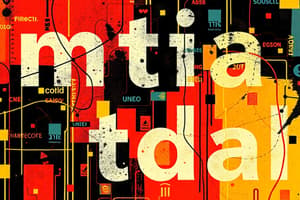Podcast
Questions and Answers
What kind of tone does the fraudulent message convey?
What kind of tone does the fraudulent message convey?
- Scary
- Formal
- Informative
- Enticing (correct)
Text-based messages can only come from established institutions.
Text-based messages can only come from established institutions.
False (B)
What is the primary purpose of text media?
What is the primary purpose of text media?
To disseminate information and convey ideas.
Text is available in different sources, both ______ and informal.
Text is available in different sources, both ______ and informal.
Match the following text characteristics with their descriptions:
Match the following text characteristics with their descriptions:
Which of the following questions should a consumer ask regarding text media content?
Which of the following questions should a consumer ask regarding text media content?
Text messages rarely contain any omitted information.
Text messages rarely contain any omitted information.
What techniques do scamming messages typically use to attract attention?
What techniques do scamming messages typically use to attract attention?
Which typeface is typically used for body text in books and newspapers?
Which typeface is typically used for body text in books and newspapers?
Slab Serif typefaces are generally thin and delicate.
Slab Serif typefaces are generally thin and delicate.
What term refers to giving importance to a part of the text-based content?
What term refers to giving importance to a part of the text-based content?
The font used for web design that provides a modern look is called _______.
The font used for web design that provides a modern look is called _______.
Match the following typefaces with their common usage:
Match the following typefaces with their common usage:
Which of the following is an example of a Decorative typeface?
Which of the following is an example of a Decorative typeface?
Proximity refers to how suitable the text is for a specific audience.
Proximity refers to how suitable the text is for a specific audience.
Name one example of a Serif typeface.
Name one example of a Serif typeface.
Which term refers to the illusion of a surface's peaks and valleys, resulting in a feeling of smoothness or roughness?
Which term refers to the illusion of a surface's peaks and valleys, resulting in a feeling of smoothness or roughness?
Symmetrical balance involves one side of a composition mirroring the other.
Symmetrical balance involves one side of a composition mirroring the other.
What is the term for the degree of light and dark within a design?
What is the term for the degree of light and dark within a design?
Color can be classified as warm, cool, or _____ .
Color can be classified as warm, cool, or _____ .
Match the design elements with their definitions:
Match the design elements with their definitions:
What determines the intensity of a color?
What determines the intensity of a color?
An area of emphasis is less important than other elements in a composition.
An area of emphasis is less important than other elements in a composition.
What is the center of interest in a composition?
What is the center of interest in a composition?
What does alignment refer to in text positioning?
What does alignment refer to in text positioning?
Repetition in design encourages the use of various typefaces on a page.
Repetition in design encourages the use of various typefaces on a page.
What is the main purpose of visual information?
What is the main purpose of visual information?
Visual media produced by schools or government agencies is referred to as _____ media.
Visual media produced by schools or government agencies is referred to as _____ media.
Which of the following is NOT a type of visual media?
Which of the following is NOT a type of visual media?
Contrast is achieved when two elements are very similar.
Contrast is achieved when two elements are very similar.
What type of alignment places text to the left of the page?
What type of alignment places text to the left of the page?
Match the design principles with their definitions:
Match the design principles with their definitions:
Flashcards
Text Definition
Text Definition
A simple and flexible format of presenting information or conveying ideas, regardless of whether it is handwritten, printed, or displayed on-screen.
Text's Purpose
Text's Purpose
A text carefully crafted to convey a specific message to its intended audience. Can be as short as a single sentence or as long as a news article.
Formal Text
Formal Text
Formal text materials are created and distributed by recognized institutions, like publishing companies or news agencies. They undergo a rigorous editing and evaluation process, often subject to censorship.
Informal Text
Informal Text
Signup and view all the flashcards
Power of Text
Power of Text
Signup and view all the flashcards
Typeface
Typeface
Signup and view all the flashcards
Critical Consumption
Critical Consumption
Signup and view all the flashcards
Text and Information
Text and Information
Signup and view all the flashcards
What is the dominant means of communication when visual elements are not present?
What is the dominant means of communication when visual elements are not present?
Signup and view all the flashcards
What are Serif fonts?
What are Serif fonts?
Signup and view all the flashcards
What are Sans Serif fonts?
What are Sans Serif fonts?
Signup and view all the flashcards
What are Slab Serif fonts?
What are Slab Serif fonts?
Signup and view all the flashcards
What are Script fonts?
What are Script fonts?
Signup and view all the flashcards
What are Decorative fonts?
What are Decorative fonts?
Signup and view all the flashcards
What is Emphasis in text-based content?
What is Emphasis in text-based content?
Signup and view all the flashcards
What is Proximity in text-based content?
What is Proximity in text-based content?
Signup and view all the flashcards
Alignment
Alignment
Signup and view all the flashcards
Organization
Organization
Signup and view all the flashcards
Repetition
Repetition
Signup and view all the flashcards
Contrast
Contrast
Signup and view all the flashcards
Visual Media
Visual Media
Signup and view all the flashcards
Formal Visual Media
Formal Visual Media
Signup and view all the flashcards
Informal Visual Media
Informal Visual Media
Signup and view all the flashcards
Purpose of Visual Information
Purpose of Visual Information
Signup and view all the flashcards
Value
Value
Signup and view all the flashcards
Form
Form
Signup and view all the flashcards
Balance
Balance
Signup and view all the flashcards
Symmetrical Balance
Symmetrical Balance
Signup and view all the flashcards
Asymmetrical Balance
Asymmetrical Balance
Signup and view all the flashcards
Harmony
Harmony
Signup and view all the flashcards
Center of Interest
Center of Interest
Signup and view all the flashcards
Study Notes
Text Media and Information - Lesson 10
- Text media encompasses various formats, including hand-written, printed, and on-screen content.
- Text serves as a powerful tool for disseminating information, providing direction, and suggesting ideas.
- Text is available in diverse forms, ranging from formal sources (like publications and news agencies) to informal texts (personal opinions and views). Formal texts often undergo rigorous editing and evaluation, potentially under censorship.
- Text can range from brief phrases to lengthy articles and reports.
- Text serves the important purpose of conveying a clear message to its target audience.
Analyzing Text Media
- A presented fraudulent message, ostensibly from a company, instructs the recipient to disclose their bank account details in exchange for a large sum of money (500,000 pesos) purportedly won in a raffle
- Analysis of the scam message's tone would classify it as enticing rather than scary, informative or formal.
- Questions regarding the fraudulent message's effectiveness among Filipinos could explore cultural and societal factors that contribute to susceptibility to such scams.
What is a Text?
- Text is a flexible format for conveying information, regardless of its form—handwritten, printed, or displayed on a screen.
Characteristics of a Text
- Text is powerful, disseminating information, and offering guidance and suggestions.
- Text takes various forms, encompassing both formal and informal sources.
- Formal texts, produced by established institutions, undergo stringent editing and evaluation, governed by censorship.
- Informal texts originate from personal opinions or viewpoints on various subjects.
Characteristics of a Text (Continued)
- Text can be short (a single sentence or phrase) or long (news articles or research reports).
- Regardless of length, text is carefully crafted to convey a specific message to a defined target audience.
Questions Regarding Text Media and Information
- Inquiries about text media focus on its source, attention-grabbing techniques utilized, the writer's language style, representation of views, and potential interpretations.
- Inquiries also concern omitted, obscured, or added parts of the message.
Text as Visuals
- Text can be used visually in various ways.
Typeface
- Typeface refers to the style and appearance of text.
- It comprises alphabets, symbols, and punctuation.
- Typeface selection influences the message conveyed.
Types of Typefaces: Serif
- Serif fonts, commonly used in books and newspapers, are often associated with formality and readability.
- Common serif fonts include Times New Roman, Garamond, and Baskerville.
- Serifs contribute to a classic style.
Types of Typefaces: Sans Serif
- Sans serif fonts generally convey a clean and minimalist aesthetic.
- They're often employed for signage, building directories, and webpage design.
- Popular sans serif fonts include Arial, Helvetica, Tahoma, Verdana, and Calibri.
Types of Typefaces: Slab Serif
- Slab serif fonts possess a substantial visual weight, frequently employed in large advertising displays on billboards or signage.
- Examples of slab serif fonts include Rockwell and Playbill.
Types of Typefaces: Script
- Script fonts, renowned for their flowing strokes, often draw considerable attention.
- Their use should be limited to avoid detracting from other content elements.
- Script fonts are suitable for formal events like wedding invitations. Popular script fonts include Edwardian, Ludwig, and Kunsler.
Types of Typefaces: Decorative
- Decorative fonts are designed to convey a wide range of emotions or themes.
- Examples of decorative fonts include Chiller, Jokerman, and Curlz MT.
Design Principles and Elements
- Design elements are used for emphasizing essential information. Employing boldface or italicizing text can set it apart. Using color variations, especially on contrasting backgrounds, further enhances visual impact. Adjusting text size can improve emphasis and visibility.
Design Principles and Elements: Appropriateness
- Appropriateness refers to selecting text suitable for its target viewers, purpose, and intended event.
Design Principles and Elements: Proximity
- Proximity refers to the arrangement of text elements. Close placement suggests relationships, while spread-out layout indicates independence.
Design Principles and Elements: Alignment
- Alignment refers to the positioning of text on a page. Common positions include left, right, center, or justified.
Design Principles and Elements: Organization
- Organization of text elements within a page facilitates understanding. Text elements can be grouped together or placed apart while maintaining connection.
Design Principles and Elements: Repetition
- Repetition promotes unity in design. Repeating certain typeface elements maintains a consistent flow. Avoiding excessive use of different typefaces minimizes distractions.
Design Principles and Elements: Contrast
- Contrast is crucial for creating visual interest. Varying elements (like background color and text color) enhances readability and prominence.
Visual Information and Media
- Visual media comprises information presented through images, illustrations, or digital reproductions. Visual media, as delivered through applications, websites, or other programs, provides effective learning tools.
Visual Media: Types
- Visual media encompasses diverse forms, including photography, videos, screenshots, infographics, data visualizations, charts, graphs, comic strips, cartoons, internet memes, and visual note-taking.
Visual Media: Production
- Visual media can be formally or informally produced. Formally produced media originates from schools, governments, or publishing organizations. Informal media comes from diverse sources.
Purpose of Visual Information
- The primary goal of visual information is to capture attention, convey meaning, and facilitate retention.
Visual Design Elements: Line
- Lines form shapes, create texture, and can be thick or thin, actual, implied, vertical, horizontal, diagonal, or contour.
Visual Design Elements: Shape
- Shapes are geometric or organic areas distinguished from surrounding space through differences in value (lightness/darkness), color, or texture.
Visual Design Elements: Value
- Value illustrates the degree of light or dark in a design. Differences in value (light and dark) create contrast.
Visual Design Elements: Texture
- Texture displays a surface's perceived feel. Visual texture depicts peaks and valleys, contributing to smoothness or roughness.
Visual Design Elements: Color
- Color defines hue (name), intensity (purity), and value (lightness/darkness). Colors can highlight aspects of a design, influence viewer emotions, and be warm, cool, or neutral.
Visual Design Elements: Form
- Form describes objects with volume and thickness. Creating implied depth is accomplished through light and shadow. Form allows for diverse viewing perspectives.
Visual Design Principles: Center of Interest
- The center of interest is the area in a composition that immediately draws attention, potentially through diverse elements like values, colors, or placement.
Visual Design Principles: Balance
- Balance demonstrates visual equality across elements, enabling symmetry or asymmetry. Factors like shapes, values, colors, textures, and forms contribute to balance within a composition.
Visual Design Principles: Symmetrical Balance
- In symmetrical balance, one side mirror reflects the other.
Visual Design Principles: Asymmetrical Balance
- Asymmetrical balance occurs when one side doesn't mirror the other.
Visual Design Principles: Harmony
- Harmony unifies art elements, combining repetition with a consistent yet diverse aesthetic. Harmony avoids monotony and chaos; it seeks a unified visual experience.
Visual Design Principles: Contrast
- Contrast highlights differences between elements, leading to the prominence of objects or focus areas. Emphasizing difference through placement, color, or texture is pivotal in composition.
Visual Design Principles: Rhythm and Movement
- Rhythm and movement involve a visual flow within a design. Movement occurs by directing attention visually from one element to another, utilizing value or placement. The movement or path of the viewer's eye is an important facet of compositional structure.
Activity: Making Infographics
- Students collaborate in groups of three.
- They research facts and figures on chosen social or ethical issues within media and information literacy.
- Using desktop publishing software, they create infographics, employing design principles and elements as discussed in the course to effectively convey the relevant information.
- The project output is submitted to the classroom's designated portal (Google Classroom).
Infographic Maker Software Recommendations
- A selection of twelve best infographic creation software is provided.
Additional Information
- Various examples of infographics and social media statistics from 2016 are referenced to enhance understanding. Visual examples are available.
Studying That Suits You
Use AI to generate personalized quizzes and flashcards to suit your learning preferences.




